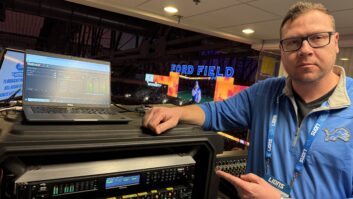(click thumbnail)Herb Jepko at KSL, probably in the mid-1960s. Photos courtesy Dr. Joseph BuchmanHerb Jepko was different. He was cordial to his guests, friendly to his callers; he never raised his voice. His “Nitecaps” show had two rules: no politics and no religion were to be discussed.
His show started during the mid-1960s, when one of the most popular talkers was Joe Pyne, known for shouting at guests and insulting anyone whose opinion he disliked.
But even on shows where the host wasn’t rude, contentious issues like civil rights, feminism and the Vietnam war dominated the times. There was none of that on the Jepko show.
Some critics called the program dull. Faithful listeners disagreed and appreciated him for providing comfort and companionship.
L.A. influence
Herb Jepko didn’t expect to become a talk show host. In fact, at one point, he thought of becoming a doctor. His childhood was difficult; he was adopted as an infant by Metro and Nellie Jepko of Prescott, Ariz., but that marriage broke up and his adoptive mother left.
His father, a wounded veteran of the First World War, took ill and couldn’t take care of him, so the young Jepko ended up in a number of foster homes. In the late ’40s, his father was able to resume his care and they moved to Phoenix, where Herb graduated from high school in 1949.
(click thumbnail)Though he wanted to be a doctor, there was no money for college. The Korean War was going on, and the young man was drafted into the army.
There Jepko discovered broadcasting, becoming chief of radio-television operations for his division. He produced 18 weekly radio shows plus military training films, and was based in California.
When his service ended in 1954, he remained on the West Coast, working as assistant station manager at KVNA in Flagstaff and then as promotion director of KFI in Los Angeles.
There, Jepko was impressed with the station’s late-night announcer, Ben Hunter, who did a call-in program called the “Night Owl” show. Overnight shows were still fairly new in the 1950s, and Hunter’s style would influence some of what Herb Jepko later did on the air.
While working in L.A., he met Patsy Little Brown, the woman who became the love of his life. They married, and Patsy soon became an integral part of Herb’s radio success.
By 1961, the couple had moved to Salt Lake City, where her family lived. Jepko found on-air work at several small stations; two of the earliest were KCPX in Salt Lake City and KANN in nearby Ogden. His big break came in 1962, when 50,000 watt powerhouse KSL hired him, first for mid-days and later morning drive.
(click thumbnail)But despite holding a visible time slot on the number one station, Herb wondered about overnights.
At the time, KSL went off the air at midnight, which seemed like a waste of the station’s powerful signal. Jepko had seen how successful Hunter’s overnight show was, so he suggested an all-night show to KSL management. They were skeptical and told him to take a pay cut if he wanted to do that shift.
He was given a six-week period to prove there was an audience. He took the challenge and on Feb. 11, 1964, his show debuted overnights, as he wanted. At the time it was referred to in radio listings as “The Other Side of the Day” but within a few months, the Jepko program became “Nitecaps.” Fans began to call themselves Nitecaps.
Sincere
From the outset, it reflected Jepko’s philosophy.
Listeners could call and talk about anything, as long as it wasn’t a controversial subject. As he would often tell interviewers, he took pride in the fact that he never embarrassed or insulted a listener, nor did he give anyone an ulcer.
He cared about his listeners; even if they hadn’t called for a while he remembered their names, and he seemed genuinely interested in how they were doing. Perhaps his audience, many of whom were elderly, became for him the family he rarely had as a child.
Thanks to KSL’s strong signal, Jepko’s overnight show was heard in distant cities. Though it had no toll-free number and took no collect calls — this at a time when long-distance calls were expensive — people waited patiently to get through.
(click thumbnail)It wasn’t long before Jepko had proven his point: There really were people out there listening late at night: shut-ins, truckers, shift-workers and lots of insomniacs, all eager to talk to Jepko and other Nitecaps.
Some had a poem they wanted to read. Some tried to sing. Some shared a recipe, or talked about their grandchildren.
Perhaps that is why critics found the show frustrating. Like TV’s Seinfeld, it was “a show about nothing” — it had no central theme, no excitement, no feuding guests. Yet listening became like a religion for Nitecaps fans.
Jepko sounded like everyone’s best pal, but he also understood good radio. To make sure the conversation didn’t drag, he had a device known as “Tinkerbell,” a music box that played the theme from the movie “Never on Sunday.”
A caller got five minutes maximum; then the sound of Tinkerbell would remind the caller time was up. There were other rules too, such as being allowed to call only once every two weeks.
His vision for the show involved more than just chatting. He wanted to use it to do good for others and helping those less fortunate.
Since his listeners regarded the show as a community, he created a club for them in mid-1964. A year after the Nitecaps International Association was born, there were more than 25,000 active members.
Nitecaps also organized into local groups, or Nitestands; in addition to monthly meetings, each devoted itself to a particular charitable endeavor, like visiting the sick or reading to the blind. A 1967 article noted the existence of more than 100 Nitestands, with 27,000 members in Southern California alone.
(click thumbnail)The show had its own theme song, “We’re the Nitecaps,” a cheerful piece written by devoted fan Della Dame Edmunds.
The Nitecaps had an official magazine, “The Wick.” Its pages contained some of the same features as the show, like recipes and what various Nightstands were doing. The publication included inspirational messages from Jepko as well as photographs. In the pre-Internet era, readers anticipated pictures eagerly; members in each city wanted to see what others looked like.
Show-related merchandise was advertised in The Wick; at first, Jepko and his wife filled the orders themselves, as listeners purchased Nitecap stationery, Nitecap pins, copies of the Nitecap theme song and more. Once a year, they could attend the Nitecaps convention, part of Jepko’s mission to encourage Nitecaps to meet and become friends.
Expanding
In 1968, Jepko began syndicating the program, putting it on several radio stations in addition to KSL. The couple managed the syndication themselves, and the first affiliate was KXIV in Phoenix.
In 1966, he’d had only four phone lines, but within five years an Associated Press article was estimating that Jepko had more than 2 million listeners and needed 11 lines to handle calls from all over the country. AP reported that among his fans were such celebrities as Ronald Reagan, governor of California, and singer Pat Boone.
While critics didn’t understand the show’s appeal, Herb Jepko certainly had his finger on the pulse of Main Street.
Chuck Graham, entertainment writer for the Tucson Daily Citizen in Arizona, admitted to being fascinated by the show and its devoted fans but wondered how people could get so excited about listening to “three hours of happy conversations from wholesome people.”
Yet that seems to have been the show’s charm; it made people feel good.
In 1975, Jepko had more than 20 phone lines in the studio. He’d been picking up more stations, including big signals like WHAS in Louisville, Ky., and WBAL in Baltimore. Where the staff had once been his wife and himself, he now had 25 people working for him.
Given that profile, it was not surprising that Mutual Broadcasting System, a national radio network, became interested in putting his show on its affiliates.
Where today there are many syndicated late-night shows, in 1975 there would be one: Herb Jepko’s. “Nitecaps” went on the network on Nov. 4, 1975, and would be heard coast to coast on several hundred stations. As a result, Jepko is considered a pioneer in overnight syndicated radio talk.
19-month run
This should have been the start of something big for Jepko; unfortunately, it turned out to be a disaster.
There was tension from the beginning, with Mutual executives increasingly uncomfortable about the show’s folksy and non-confrontational style.
According to Jepko, he was told to make the show more controversial and was asked to move closer to the corporate headquarters in Arlington, Va. He said no to both.
But the real problem was sales. Mutual had never broadcast an overnight show, and its sales force had no idea how to sell all-night radio, especially radio aimed at an older audience. This, at least, is how Jepko related the problem to a New York Times reporter in 1977.
In the end, there were not enough commercials to generate sufficient revenue. Mutual cancelled the show in May of that year.
It was a disappointment for Jepko and for his audience. He continued to work at KSL until August of 1979, but then his home station too cancelled the show.
Jepko tried to get back into radio but was never able to recapture his success. A group of fans in San Diego helped him get back on the air in June of 1981, broadcasting from KMJC in El Cajon, Calif., and on a few small stations. But that experiment did not last, nor did a subsequent effort in October 1982. The era of the Nitecaps was over.
As the industry changed around him, he grew increasingly more depressed, according to a 1995 account in the Salt Lake City Tribune, exacerbated by the death of his son Herb Jr. from AIDS and his own declining health (he suffered from severe arthritis).
In late March 1995, Herb Jepko died at the age of 64.
Long lonely nights
To this day, there are former Nitecaps who recall being on his show. A Web site has been put up in his memory by a friend of the Jepko family, Prof. Joseph Buchman, at www.nitecaps.net.
“My first job in radio was running the board for The Nitecap Radio Network from midnight to 6 a.m. on 250-watt WXVW(AM) 1450 in Jeffersonville, Ind.,” Buchman wrote on the Web site.
“I remember those long, lonely nights well; listening to Nitecaps from around the country interact with Herb, discuss the activities of their Nitestands, the latest article in The Wick, their grandchildren, recipes (often with Herb’s pal ‘The Crusher’), and opening a window to what was, truly, a radio family.”
Buchman credits Jepko for showing a path that allowed talent like Larry King, Art Bell, Phil Donahue and Ellen DeGeneres to flourish.
In June 2003, the Utah Association of Broadcasters Hall of Fame gave Jepko a posthumous award, establishing a scholarship in his memory.
There may be no place on today’s radio for a kinder, gentler show like Herb Jepko’s. Based on the comments left by fans on Buchman’s Web site, plenty of folks think that’s a shame.












